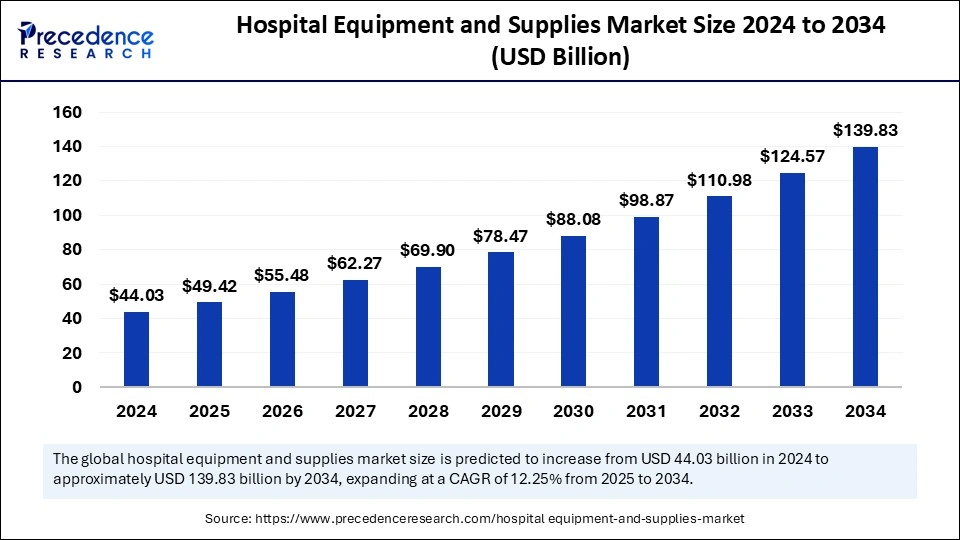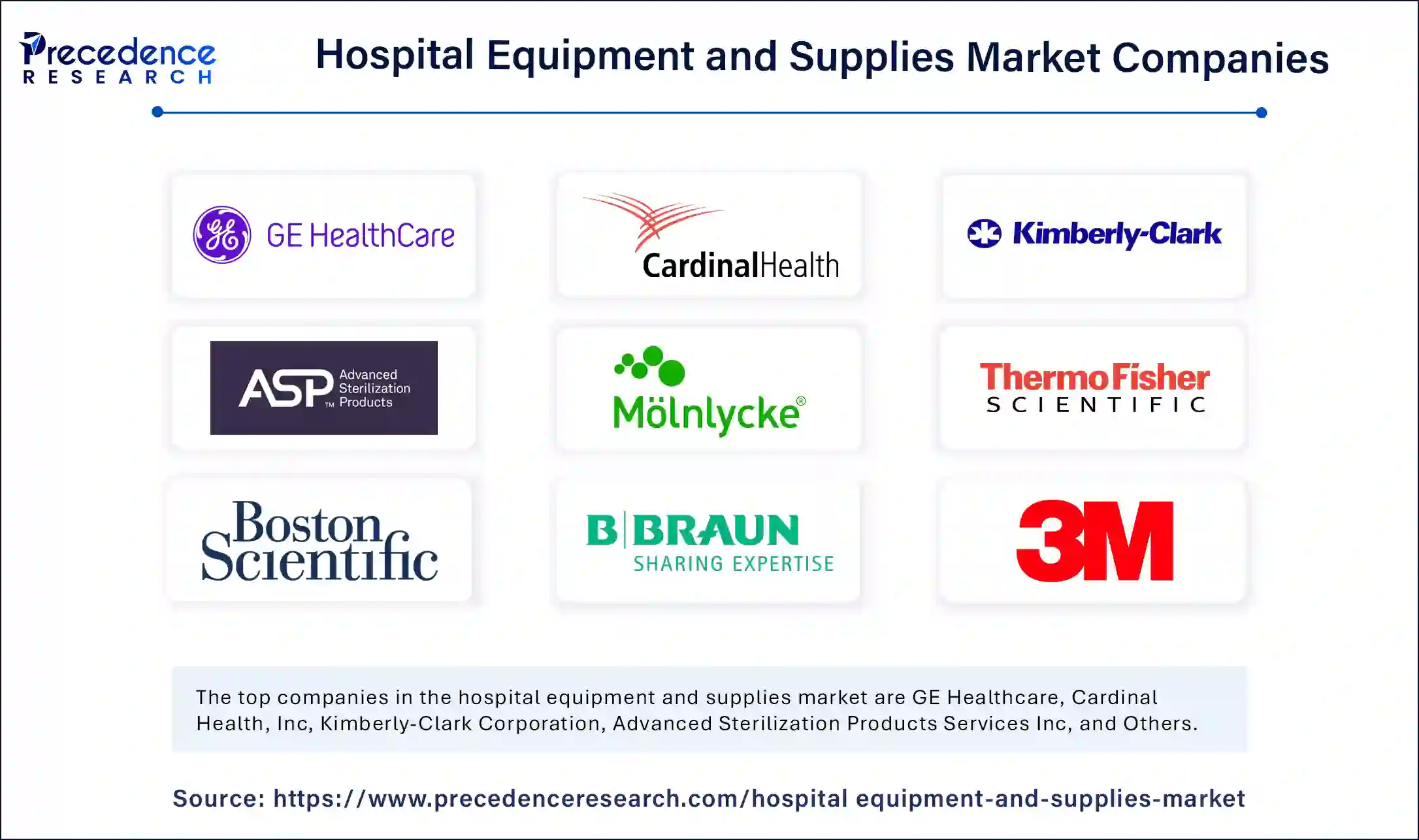January 2025
The global hospital equipment and supplies market size is calculated at USD 49.42 billion in 2025 and is forecasted to reach around USD 139.83 billion by 2034, accelerating at a CAGR of 12.25% from 2025 to 2034. The market sizing and forecasts are revenue-based (USD Million/Billion), with 2024 as the base year.
The global hospital equipment and supplies market size was estimated at USD 44.03 billion in 2024 and is predicted to increase from USD 49.42 billion in 2025 to approximately USD 139.83 billion by 2034, expanding at a CAGR of 12.25% from 2025 to 2034. The increasing prevalence of chronic diseases worldwide, rising healthcare expenditure, rising emphasis on measures to control hospital-acquired infections (HAIs), and technological innovations in hospital equipment are among several factors expected to drive the growth of the hospital equipment and supplies market throughout the projection period.

Artificial intelligence (AI) is emerging as a driving force in the global hospital equipment and supplies market. The integration of AI and Machine Learning (ML) into healthcare facilities is significantly transforming the way hospitals and clinics operate. The adoption of these technologies is turning ordinary medical equipment into extraordinary tools for diagnosis, treatment, and patient monitoring. From automating administrative tasks to enhancing patient care, AI-driven solutions are playing an integral role in modern medical facilities. With advancements in device design and the optimization of production processes, AI has enhanced the efficiency, quality, and personalization of healthcare devices. Therefore, AI integration in clinics and hospitals can significantly improve patient care, enhance efficiency, and ensure compliance with industry standards.
Hospital equipment and supplies play an integral role in the healthcare industry. They significantly impact ongoing patient care and offer intensive treatments. Medical supplies refer to the consumable and often disposable items that assist in the treatment and care of patients. Hospital supplies are generally designed for immediate use and assist in minor procedures, such as measuring temperature or cleaning a wound. Hospital equipment and hospital supplies can assist in providing better patient care.
The hospital equipment and supplies market is witnessing rapid growth due to the increasing demand for disposable hospital supplies. Medical supplies are extensively utilized in healthcare settings to help diagnose, treat, and effectively manage patients' health. These items are often single-use or short-term-use products. Medical supplies are often less expensive and are generally disposed of after use. Some of the common examples of medical supplies include bandages, syringes, gloves and masks, adhesive tapes, thermometers, IV fluids, and drips. These products play an integral role in performing everyday medical tasks and procedures, ensuring the safety and well-being of patients.
| Report Coverage | Details |
| Market Size by 2034 | USD 139.83 Billion |
| Market Size in 2025 | USD 49.42 Billion |
| Market Size in 2024 | USD 44.03 Billion |
| Market Growth Rate from 2025 to 2034 | CAGR of 12.25% |
| Dominating Region | North America |
| Fastest Growing Region | Europe |
| Base Year | 2024 |
| Forecast Period | 2025 to 2034 |
| Segments Covered | Type, End-User, and Regions |
| Regions Covered | North America, Europe, Asia-Pacific, Latin America, and Middle East & Africa |
Increasing Prevalence of Chronic Diseases
The rising incidence of chronic conditions around the world is one of the key factors boosting the growth of the hospital equipment and supplies market. Patients with chronic disorders such as heart disease, stroke, HIV, tuberculosis, kidney disease, cancer, and diabetes often require frequent diagnostics and surgical interventions, which necessitate a large stock of medical devices and consumables. In addition, growing awareness about hospital-acquired infections (HAIs) has significantly increased the usage of disposable supplies across various healthcare facilities.
High Cost
The high cost associated with advanced medical equipment hampers the growth of the hospital equipment and supplies market. The high cost of advanced and innovative hospital equipment creates challenges for small healthcare organizations, resulting in slow adoption due to budget constraints. In addition, strict regulatory approvals and compliance standards may restrict the expansion of the market. The approval processes for new medical devices are often so lengthy that they can delay entry into the market.
Rapid Expansion of Healthcare Facilities
The rapid expansion of healthcare facilities around the world is projected to offer lucrative growth opportunities in the hospital equipment and supplies market. Hospital equipment, such as defibrillators, oxygen concentrators, and x-ray machines, and supplies, such as disposable gloves, sterile gauze, and surgical masks, play a crucial role in both diagnostics and surgical procedures. The increasing investment in the expansion of healthcare infrastructure has led to increasing demand for hospital equipment and supplies, allowing medical professionals to utilize the broad range of products and devices necessary for better patient care, accurate diagnosis, and better treatment outcomes. Additionally, healthcare providers are required to comply with stringent regulations to ensure patient safety and maintain a high quality of care. Proper equipment maintenance, along with appropriate stocking and disposal of supplies, is critical for meeting safety standards.
The sterilization consumables segment dominated the hospital equipment and supplies market with the largest share in 2024. This is mainly due to the strong focus on controlling hospital-acquired infections (HAIs). Sterilization consumables are widely used in healthcare facilities to ensure patient safety and improve treatment outcomes. Sterilization and disinfectant equipment includes an autoclave, ethylene oxide (ETO) sterilizer, chemical vapor sterilizer, and high-level disinfectant. These consumables prevent infections, enhancing patient care.
The wound care products segment is expected to grow at a significant rate during the projection period. With the rising number of surgical procedures, the demand for wound care products is increasing. Wound care products prevent infection risks, promoting wound healing. The growing prevalence of chronic diseases leads to chronic wounds, boosting the demand for wound care products. Moreover, the rising development of novel wound care products supports segmental growth.
The hospitals segment registered its dominance in the hospital equipment and supplies market in 2024, owing to the rise in utilization of disposable hospital supplies and advanced medical technologies such as AI-enabled medical devices. In developing nations, governments are increasingly collaborating with private hospitals to expand healthcare services and boost supply chain efficiency. Governments worldwide are investing heavily in improving hospital infrastructure to enhance patient care, significantly influencing the segment. Moreover, the rise in the patient pool in hospitals bolstered the segment.
North America dominated the hospital equipment and supplies market by holding the largest share in 2024. The region’s dominance is attributed to the strong presence of sophisticated healthcare facilities, the rise in the incidence of chronic diseases, and heightened awareness of medical hygiene standards. There is a significant rise in the number of surgeries, boosting the need for sterilization consumables and wound care products. The rise in spending on R&D activities, high demand for disposable medical supplies, favorable government framework, and rapid technological integration in modern healthcare facilities further bolstered regional market growth.
The region is likely to continue its growth trajectory in the near future. This is mainly due to a strong emphasis on utilizing disposable supplies to lower the prevalence of hospital-acquired infections (HAIs). Several regional market players are focusing on developing innovative hospital equipment and supplies to meet the evolving needs of consumers. Prominent players continue to drive innovation through new product launches, mergers, acquisitions, and partnerships to gain a competitive edge and boost their presence in the market.
Europe is anticipated to witness rapid growth in the coming years. The regional market growth is mainly attributed to the presence of well-established healthcare facilities, rising R&D expenditures, increasing number of hospitals and diagnostic labs, rising awareness regarding medical hygiene standards, rising prevalence of chronic disorders, rising utilization of disposable medical supplies, rising focus to minimize hospital acquired infection (HAIs), and ongoing technological integration in healthcare operations. Several European countries are heavily investing in modernizing healthcare infrastructure, along with the rapid adoption of innovative hospital technologies, which is expected to propel the growth of the hospital equipment and supplies market in the region during the forecast period.
Asia Pacific is expected to witness notable growth during the forecast period. Factors such as expansion of healthcare facilities, rapid population growth, rising healthcare expenditure, surge in the elderly population, rapid integration of advanced medical technologies, an increase in surgical procedures, increasing demand for early detection tools, growing awareness regarding the availability of advanced hospital equipment and supplies, and rising private and public investments to enhance the healthcare infrastructure to support advanced healthcare facilities are expected to boost the regional market growth. In addition, the increasing prevalence of chronic diseases such as cancer, orthopedic disorders, cardiovascular disorders, and kidney diseases is expected to contribute to market expansion.

By Type
By End-User
By Region
For inquiries regarding discounts, bulk purchases, or customization requests, please contact us at sales@precedenceresearch.com
No cookie-cutter, only authentic analysis – take the 1st step to become a Precedence Research client
January 2025
January 2024
September 2024
January 2025